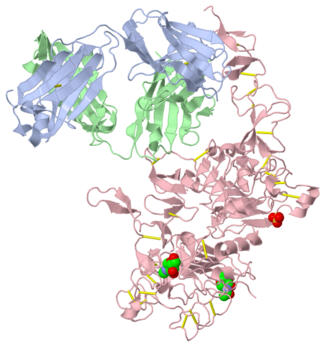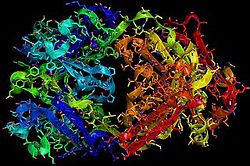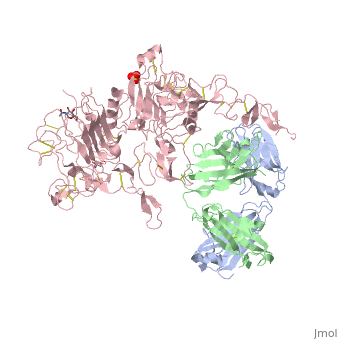Herceptin - Mechanism of Action
From Proteopedia
| Line 43: | Line 43: | ||
=== Herceptin === | === Herceptin === | ||
| - | <scene name='Sandbox_reserved_Herceptin/Herceptin/1'>Herceptin</scene> is a monoclonal antibody proven to be a clinically effective treatment in fighting HER2+ breast cancer. There is also some clinical evidence suggesting that Herceptin enhances the effects of chemotherapy. Herceptin binds to the juxtamembrane region of HER2 on the C-terminal portion of sub-domain IV. The interaction formed by Herceptin and HER2 is mediated by three regions on HER2 that form three loops: residues 557-561 (loop 1), 570-573 (loop 2), and 593-603 (loop 3). Loops 1 and 3 are formed primarily by electrostatic interactions and loop 2 is formed by hydrophobic contacts. Herceptin acts by four different mechanisms of action: | + | <scene name='Sandbox_reserved_Herceptin/Herceptin/1'>Herceptin</scene> is a monoclonal antibody proven to be a clinically effective treatment in fighting HER2+ breast cancer. There is also some clinical evidence suggesting that Herceptin enhances the effects of chemotherapy. Herceptin binds to the juxtamembrane region of HER2 on the C-terminal portion of sub-domain IV. The interaction formed by Herceptin and HER2 is mediated by three regions on HER2 that form three loops: residues 557-561 (loop 1), 570-573 (loop 2), and 593-603 (loop 3). Loops 1 and 3 are formed primarily by electrostatic interactions and loop 2 is formed by hydrophobic contacts. The key amino acids involved in the interaction between HER2 and Herceptin can be seen <scene name='Sandbox_reserved_Herceptin/Interactions1/2'>here</scene>. Herceptin's key amino acids (green) include: Asn 30 and Thr 94 on the light chain and Tyr 33, Arg 50, Trp 99, Gly 103, and Tyr 105 on the heavy chain. Key amino acids involved in HER2 are as follows: loop 1 (blue) which includes Glu 558 and Asp 560, loop 2 (pink) which includes Asp 570 and Phe 573, and loop 3 (orange) which includes Gln 602. Herceptin acts by four different mechanisms of action: |
*activation of antibody-dependent cellular cytotoxicity | *activation of antibody-dependent cellular cytotoxicity | ||
*prevention of formation of p95HER2 | *prevention of formation of p95HER2 | ||
Revision as of 03:38, 8 November 2012

Basics
Introduction
Breast cancer is the most common type of cancer found among women. Although it is rarely seen in men, one in eight women will be diagnosed with breast cancer within their lifetime. Patients exhibiting an over-expression in Human Epidermal Growth Factor Receptor 2 (HER2) account for 25% of all breast cancer. HER2+ patients often experience a more aggressive cancer resulting in more metastasized tumors. The statistics show a poor prognosis for HER2+ patients with a 5-year survival rate of 68%. Herceptin (also known as trastuzumab) was approved by the FDA in September of 1998 for HER2+ patients and has been shown to be an effective tool in the battle against breast cancer.
HER2
HER2 is one of four human epidermal growth factor receptors (EGFR , HER2, HER3, and HER4). These receptors are part of a family of receptor tyrosine kinases responsible for cell proliferation and differentiation.These human epidermal growth factor receptors exist on the cell surface and, with the exception of HER2, bind to specific ligands (epidermal growth factors). Over 11 different ligands for the Epidermal Growth Factor Receptors have been identified. After binding with these ligands the receptor tyrosine kinases are able to homo-dimerise (with the exception of HER2) or hetero-dimerise with one another. This dimerization causes a cross-phosphorylation between the two receptors and ultimately activates a cell signaling pathway causing cell division.
HER2 is the only receptor within this family that is constitutively active being able to dimerise with other receptor tyrosine kinases acting in a ligand-independent manner. This continuous activation of the cell signal pathway causes an increase in cell division; thus, potentially causing a tumor.
Herceptin
Herceptin, generic trastuzumab, is a monoclonal antibody. Herceptin is an effective treatment for breast cancer for the reason that it binds to the extracellular domain of HER2 and, by multiple mechanisms of action, can prevent cell proliferation as well as target these HER2+ cells for destruction by the immune system. By these mechanisms Herceptin is an effective treatment for breast cancer.
| |||||||||||



